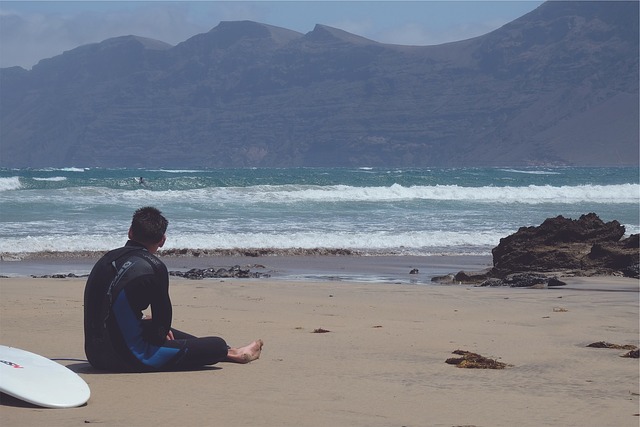For beginners in surfing, selecting the appropriate surfboard setup is crucial for an enjoyable learning experience and progression. A surfboard for beginners should ideally feature a single fin or a thruster setup, which offers a balance between stability and maneuverability, allowing novices to focus on mastering wave dynamics and turns without the complexity of adjusting multiple fins. Longboards with single fins are recommended as they provide a stable and forgiving platform suitable for paddling into waves and developing foundational skills. As surfers advance, twin fin setups can be introduced for their more responsive turns and looser feel, which is a step up from the simplicity of a single fin. For those seeking to further refine their experience, a five-fin setup allows for versatile fin positions that can be adjusted for different conditions, catering to intermediate and advanced surfers looking for enhanced control and speed. It's important for beginners to practice with each configuration in gentle waves before attempting more challenging waters to ensure they remain balanced and confident as their skills develop alongside their chosen surfboard setup.
Embarking on the journey of mastering the art of surfing begins with understanding the pivotal role that fins play in your surfboard’s performance. Whether you’re a novice rider or an experienced wave-rider, the fin configuration can significantly influence your experience on the water. This article delves into the essential aspects of single versus multiple fin setups, tracing their evolution from the classic thruster to modern quad designs. We’ll guide you through selecting the ideal fin setup for a beginner surfboard and explore how each configuration impacts stability and maneuverability. By the end, you’ll be well-equipped to transition between different fin setups, enhancing your surfing skills and confidence in the waves.
Understanding Surfboard Fins for Beginners: The Basics

For those embarking on their surfing journey, grasping the fundamentals of surfboard fins is crucial for improving performance and understanding how a board interacts with the water. Surfboard fins, typically found at the tail and sometimes at the center of the board, are key components that influence a surfer’s speed, turning capacity, and stability both in and out of the wave. Beginners should familiarize themselves with the two main types of fins: the thruster and the single fin. A thruster setup consists of three fins – one centered fin (the keel) and two smaller side fins (the twinnies). This configuration offers a balance between hold and maneuverability, making it an excellent choice for beginners. The single fin setup, on the other hand, features just one fin at the center of the board, providing a smoother ride with less resistance, which can be easier to handle for those new to the sport.
When selecting a surfboard for beginners, considering the type of fins is essential. Longboards often come with a single fin, offering a stable and predictable feel that’s perfect for learning to stand up and ride longer, more drawn-out waves. Shortboards, which are more maneuverable, usually have the thruster setup and are designed for smaller, tighter waves, making them a better fit as a surfer’s skills advance. Understanding the role of fins in surfboard performance can significantly enhance a beginner’s experience, whether they opt for the simplicity of a single fin or the versatility of a thruster setup. As you progress and explore different types of waves and conditions, you may experiment with various fin configurations to find what best suits your style and preferences.
Single Fin vs. Multi-Fin Setups: Pros and Cons

When evaluating single fin versus multi-fin setup for beginners, it’s crucial to understand how each can influence learning and performance in the water. A single fin, or thruster, setup typically consists of one central fin and two smaller side fins. This configuration offers a balance between stability and maneuverability, making it a popular choice for those new to surfing. The single fin provides a strong initial grip on the wave, which is essential for novices as they learn to position themselves correctly. Additionally, the simplicity of the design reduces the learning curve associated with fin placement and adjustment, allowing beginners to focus on mastering the basics of wave riding without the added complexity of multiple fins.
On the other hand, multi-fin setups, such as the quad or five-fin configurations, offer a different experience for surfers of all skill levels. These setups can enhance maneuverability and allow for a more dynamic interaction with the wave. For beginners who progress to these setups, the increased number of fins can aid in carving and turning, which are advanced skills that add excitement and variety to their surfing repertoire. However, it’s important for beginners to be patient as they adjust to the nuances of a multi-fin setup, as the added fins require a more attentive fin trimming and positioning, which can be challenging at first. The choice between single fin and multi-fin setups depends on the surfer’s comfort level, wave conditions, and desired performance characteristics. A surfboard for beginners with a single fin is often the best starting point, while more experienced riders might explore multi-fin options to enhance their skills and enjoyment of the sport.
The Evolution of Fin Designs: From Thrusters to Quads

The evolution of fin designs in surfing has been a dynamic journey, significantly impacting the sport’s accessibility and performance. Initially, the classic three-fin setup, or thrusters, became the standard in the late 1980s after Kelly Slater popularized this design. This configuration offered improved speed and maneuverability, making it particularly appealing to surfers of all levels, including beginners who benefit from the enhanced stability these fins provide. However, as surfing technology advanced, so did the exploration of fin designs. Today, quad fin setups are gaining popularity among both intermediate and advanced surfers. The four-fin configuration allows for a tighter turn and better grip on the wave face, which can be particularly advantageous in more powerful surf conditions. For beginners, quads offer a forgiving ride that can help them progress faster by providing a more responsive board feel. This evolution from thrusters to quads reflects the ongoing pursuit of optimizing the connection between surfer and wave, catering to a diverse range of skill levels and preferences in the surfing community. As such, both thrusters and quads remain relevant in the modern surfboard landscape, each offering unique benefits that can make learning and enjoying the sport more accessible for beginners.
Selecting the Right Fin Setup for Your Surfboard as a Novice

When embarking on the journey of mastering surfing, selecting the right fin setup for your surfboard is a critical decision, especially as a novice. A beginner’s surfboard for beginners should be equipped with fins that offer stability and ease of use to help you get accustomed to the waves and the board itself. Typically, larger single fins, known as “longboards,” provide greater stability and are more forgiving for those new to the sport. They allow for slower speed adjustments, which is beneficial when learning to read waves and make turns. The single fin setup has a simple design with one fin at the center of the tail, reducing the complexity of board handling and making it an excellent choice for beginners who are still fine-tuning their skills.
However, if you’re looking for a bit more maneuverability while still maintaining a good level of stability, consider a twin fin setup. This configuration features two smaller fins, one on each side of the tail. The twin fin design provides a balance between the paddle power and speed of a thruster (three-fin setup) with the stability of a single fin. It’s a great option for novice surfers who are ready to step up from a longboard but still require a board that offers forgiveness and ease of use on the waves. When choosing your fins, always consider the type of surf you’ll primarily be engaging in; different fin setups can react differently depending on wave conditions and personal surfing style. Remember to consult with experienced surfers or a reputable surf shop when selecting your first board and fin setup to ensure it aligns with your skill level and the kind of waves you’ll be riding.
How Fin Configuration Affects Performance and Stability in the Water

When selecting a surfboard for beginners, one critical aspect to consider is the fin configuration, as it significantly influences both performance and stability in the water. A single fin setup, commonly known as a single keel or longboard fin, offers increased stability and is more forgiving for those new to riding waves. This configuration allows beginners to paddle into waves with greater ease due to the larger surface area of the fin, which helps in tracking straight along the face of the wave. Additionally, the single fin design reduces the likelihood of pearling or nose diving, common issues for novices when attempting sharp turns.
In contrast, multiple fin setups, such as the thruster configuration found on many performance and shortboard designs, are designed to offer a balance between responsiveness and control. A thruster setup includes three fins: two smaller side fins and one larger center fin. This arrangement allows for tighter turns and more dynamic surfing maneuvers, which can be beneficial as a surfer’s skills progress beyond beginner level. The side fins provide grip and assist in maintaining speed through the turn, while the center fin helps with initial acceleration and directional control. For beginners, however, the sensitivity of a thruster might be challenging to manage, potentially leading to frustration and hindering proper form development. Therefore, when choosing between a surfboard for beginners with a single fin or multiple fins, it is important to consider the surfer’s skill level and intended use case, as fin configuration directly affects both the learning curve and the overall enjoyment of the sport.
Tips for Transitioning Between Single and Multiple Fin Configurations

When transitioning between single and multiple fin configurations on a surfboard designed for beginners, it’s beneficial to understand how each setup affects performance and maneuverability. A single fin, or thruster setup, can significantly influence the responsiveness of the board. Beginners should start with the single fin configuration as it provides stability and ease of use, which are crucial for mastering the basics of surfing. To transition to a twin fin setup, focus on adapting your positioning on the board; you’ll likely notice a difference in how the board turns, as twin fins offer quicker and looser turns compared to a thruster.
For those ready to experiment with multiple fins, a five-fin configuration allows for a range of fin positions that can be tuned to suit different surf conditions. This flexibility can enhance the performance of more advanced surfers who are accustomed to the feel of a thruster but want greater control and speed. Beginners transitioning to a five-fin setup should practice in calm waters and with a focus on maintaining their balance, as the looser and faster turns will require more finesse and body control. Adjusting to the different fin setups is a process that involves both physical adaptation and an understanding of how each configuration affects the board’s behavior. It’s important to practice regularly, gaining confidence in each setup before attempting more challenging conditions. Selecting the right surfboard for beginners that can accommodate multiple fin options can facilitate this transition and provide a solid platform for growth as skills advance.
